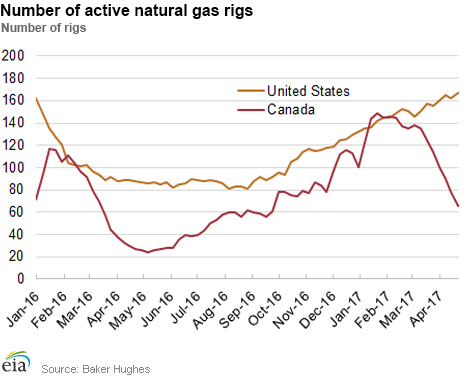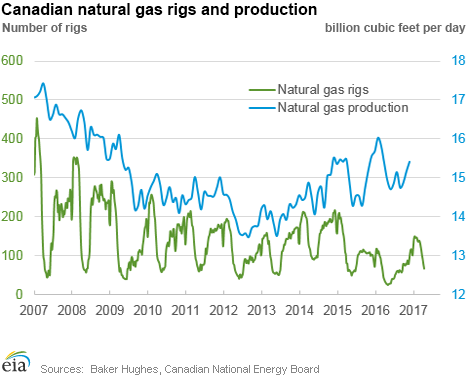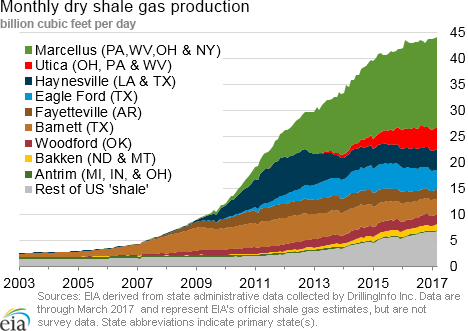In the News:
Canadian drilling drops off during spring breakup
The number of active Canadian natural gas rigs fell by 44% during the first three weeks of April, according to the most recent rig count released by Baker Hughes. On March 31, the Canadian natural gas rig count stood at 100; as of April 21, it was 66. Canadian rig counts typically decline around this time of year in what the industry characterizes as the spring breakup. Spring breakup reduces the Canadian rig count around the same time each year—generally sometime between the beginning of March and the end of May—although the exact duration is highly dependent on temperature and weather.
As warmer temperatures thaw frost-hardened ground, soft or muddy soil makes it difficult to move drilling equipment. In addition, many local governments in Canada institute road restrictions, which put strict weight limits on vehicles to prevent damage to roads. Few rigs operate during this period, as moving the necessary equipment becomes difficult. In contrast, some areas, such as bogs, are accessible to rigs only during winter months when the ground is frozen solid. As a result, Canadian rig activity is highest in the winter, when the most terrain is accessible.
Canadian natural gas production generally follows short-term drilling trends with a lag of one or two months, but the long-term relationship between active rigs and production has changed in recent years. Greater rig efficiency has reduced the number of rigs needed to sustain production levels, and has affected the number of Canadian rigs active year round. From 2013 to 2016, the average number of natural gas rigs has decreased every year, going from 120 in 2013 to 66 in 2016. At the same time, average Canadian production of natural gas has increased every year, going from an average of 14.0 billion cubic feet per day (Bcf/d) in 2013 to an average of 15.2 Bcf/d in 2016.
The Lower 48 states have milder winter conditions than Canada, and generally do not experience significant spring breakup effects. The United States added seven natural gas rigs during the first three weeks of April, and the U.S. natural gas rig count totaled 167 on April 21.
Overview:
(For the Week Ending Wednesday, April 26, 2017)
- Natural gas spot prices fell at most locations this report week (Wednesday, April 19 to Wednesday, April 26). The Henry Hub spot price fell from $3.12 per million British thermal units (MMBtu) last Wednesday to $3.02/MMBtu yesterday.
- At the New York Mercantile Exchange (Nymex), the May 2017 contract price fell to $3.142/MMBtu, down 4¢ Wednesday to Wednesday.
- Net injections to working gas totaled 74 billion cubic feet (Bcf) for the week ending April 21. Working natural gas stocks are 2,189 Bcf, which is 14% less than the year-ago level and 16% more than the five-year (2012–16) average for this week.
- The natural gas plant liquids composite price at Mont Belvieu, Texas, fell by 30¢, averaging $6.19/MMBtu for the week ending April 26. The spot prices of natural gasoline, ethane, propane, butane, and isobutane all fell by 4%, 2%, 6%, 7%, and 5%, respectively.
- According to Baker Hughes, for the week ending Friday, April 21, the natural gas rig count increased by 5 to 167. The number of oil-directed rigs rose by 5 to 688. The total rig count increased by 10, and it now stands at 857.
Prices/Supply/Demand:
Republished 5/8/2017 to correct erroneous data from PointLogic.
Prices mostly fell. This report week (Wednesday, April 19 to Wednesday, April 26), the Henry Hub spot price fell 10¢ from $3.12/MMBtu last Wednesday to $3.02/MMBtu yesterday. The southern half of the country experienced mild shoulder season weather for the report week, with relatively low air conditioning load and demand for home heating.
Yesterday's Henry Hub price was 61% higher than a year ago, when it stood at $1.88/MMBtu. Last year featured the lowest average annual Henry Hub price since 1999. This unusually low price was because of an unusually warm winter in 2015–2016, which left natural gas storage stocks at the end of the heating season at record-high levels.
At the Chicago Citygate, prices decreased 3¢ from $2.96/MMBtu last Wednesday to $2.93/MMBtu yesterday. Prices at PG&E Citygate in Northern California decreased 8¢, down from $3.35/MMBtu last Wednesday to $3.27/MMBtu yesterday. The price at SoCal Citygate decreased 10¢ from $3.20/MMBtu last Wednesday to $3.10/MMBtu yesterday.
Prices increase in Boston, but decrease elsewhere in the Northeast. At the Algonquin Citygate, which serves Boston-area consumers, prices went up 22¢ from $2.94/MMBtu last Wednesday to $3.16/MMBtu yesterday. Temperatures in the Northeast trended cooler this report week compared with the last one, supporting space heating demand.
At the Transcontinental Pipeline Zone 6 trading point for New York, prices decreased 49¢ from $3.05/MMBtu last Wednesday to $2.56/MMBtu yesterday.
Tennessee Zone 4 Marcellus spot prices decreased 13¢ from $2.55/MMBtu last Wednesday to $2.42/MMBtu yesterday. Prices at Dominion South in northwest Pennsylvania fell 25¢ from $2.72/MMBtu last Wednesday to $2.47/MMBtu yesterday.
June Nymex contract flat. At the Nymex, the May 2017 contract expired yesterday at $3.142/MMBtu, down 4¢ from last Wednesday. The June 2017 contract remained unchanged Wednesday to Wednesday at $3.271/MMBtu. The price of the 12-month strip, which averages the June 2017 through May 2018 futures contracts, increased 1¢ to $3.370/MMBtu.
Supply flat. According to data from PointLogic, the average total supply of natural gas remained the same as the previous report week, averaging 74.8 billion cubic feet per day (Bcf/d). Dry natural gas production remained constant week over week. Average net imports from Canada decreased by 2% from last week.
Demand rises slightly. Total U.S. consumption of natural gas rose by 2% compared with the previous report week, according to data from PointLogic. Week over week, power burn declined by 2%, industrial sector consumption increased by 1%, and residential/commercial sector consumption increased by 12%. Natural gas exports to Mexico increased 24% as maintenance on the NET Mexico Pipeline concluded over the weekend, and export flows were restored on the line.
Because of maintenance on the NET Mexico pipeline, the United States made its first two shipments of liquefied natural gas (LNG) to Mexico's Altamira import terminal in the Gulf of Mexico. Mexico has been the largest recipient of U.S. LNG exports, with 20 cargoes shipped since the start of LNG exports in February 2016, but all shipments prior to these two went to the Manzanillo terminal on Mexico's west coast.
U.S. LNG exports. Natural gas pipeline deliveries to the Sabine Pass liquefaction terminal averaged 1.9 Bcf/d for the report week, 15% lower than in the previous week. Three vessels (combined LNG-carrying capacity of 11.4 Bcf) departed Sabine Pass last week (Thursday to Wednesday).
Last week, the proposed Golden Pass LNG liquefaction terminal received an approval from the U.S. Department of Energy (DOE) to export up to 2.21 Bcf/d of LNG to non-Free Trade Agreement (FTA) countries for 20 years. To date, DOE has authorized 19.2 Bcf/d of LNG exports to non-FTA countries.
Storage:
Mild temperatures result in higher-than-average net injections into working gas storage. Net injections into storage totaled 74 Bcf, compared with the five-year (2012–16) average net injection of 57 Bcf and last year's net injections of 64 Bcf during the same week. Net injections into working gas during the storage week were the largest reported so far in the 2017 injection season and the largest reported this early in the refill season since April 17, 2015.
Working gas levels are 14% lower than last year's record levels, but well ahead of the five-year average. Working gas levels are 358 Bcf lower than last year's levels at this time. This year-over-year deficit prevails in each of the regions of the Lower 48 states. The South Central region has the largest year-over-year deficit of 131 Bcf. The Midwest and Pacific regions are both 48 Bcf lower than last year's levels. In contrast, working gas levels are 299 Bcf higher than the five-year average in the Lower 48 states and are higher than the five-year average in all regions except the East and the Pacific regions, which are 53 Bcf and 15 Bcf lower than the five-year average, respectively. The South Central region accounts for 222 Bcf of the surplus compared with the five-year average, and the Midwest region is 117 Bcf higher than the five-year average.
The January futures price is trading at a premium over the current spot price, but well behind last year's level at this time. During the most recent storage week, the average natural gas spot price at the Henry Hub was $3.09/MMBtu, while the Nymex futures price of natural gas for delivery in January 2018 averaged $3.62/MMBtu, a difference of 54¢. The premium was $1.10 a year ago. The price premium provides incentives for continued injections of natural gas into storage.
Reported net injections equal median of market expectations for the week. According to the Bloomberg survey of natural gas analysts, estimates of net injections to working natural gas storage ranged from 60 Bcf to 78 Bcf, with a median of 74 Bcf. Prices of the Nymex futures contract for June 2017 delivery at Henry Hub increased 1¢/MMBtu to $3.23/MMBtu in 224 trades at the release of the Weekly Natural Gas Storage Report (WNGSR). Prices varied in subsequent trading, centered on $3.24/MMBtu.
Temperatures warmer on the week in most parts of the Lower 48 states. Temperatures in the Lower 48 states averaged 61°F, 7°F higher than the normal and 4°F higher than last year at this time. Temperatures were warmer than normal in most areas of the Lower 48 states.
See also:
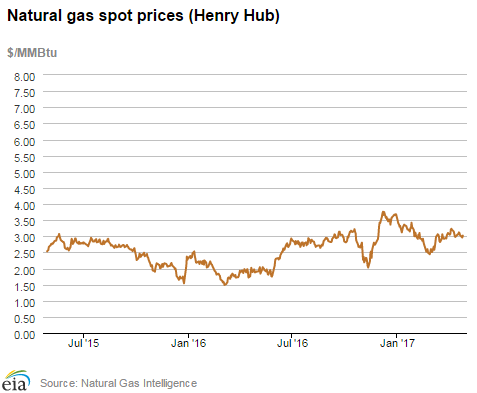
| Spot Prices ($/MMBtu) | Thu, 20-Apr |
Fri, 21-Apr |
Mon, 24-Apr |
Tue, 25-Apr |
Wed, 26-Apr |
|---|---|---|---|---|---|
| Henry Hub |
3.10 |
3.04 |
2.98 |
2.96 |
3.02 |
| New York |
2.99 |
2.92 |
2.95 |
2.63 |
2.56 |
| Chicago |
2.95 |
2.87 |
2.79 |
2.82 |
2.93 |
| Cal. Comp. Avg.* |
3.00 |
2.94 |
2.89 |
2.86 |
2.92 |
| Futures ($/MMBtu) | |||||
| May Contract | 3.159 |
3.101 |
3.066 |
3.043 |
3.142 |
| June Contract |
3.250 |
3.192 |
3.160 |
3.165 |
3.271 |
| *Avg. of NGI's reported prices for: Malin, PG&E Citygate, and Southern California Border Avg. | |||||
| Source: NGI's Daily Gas Price Index | |||||
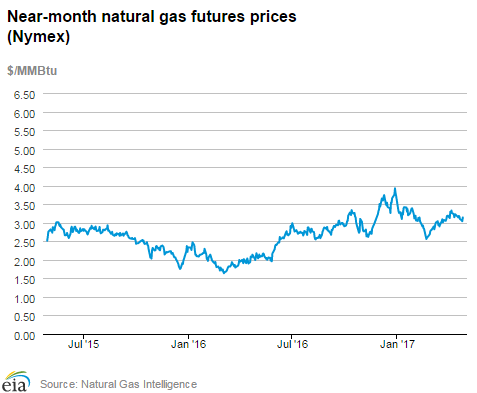
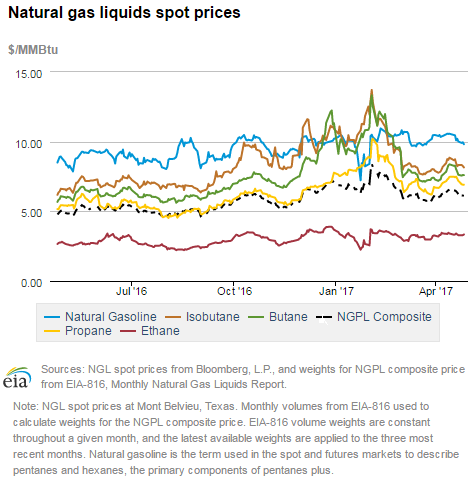
| U.S. natural gas supply - Gas Week: (4/20/17 - 4/26/17) | |||
|---|---|---|---|
Average daily values (Bcf/d): |
|||
this week |
last week |
last year |
|
| Marketed production | 78.6 |
78.7 |
80.9 |
| Dry production | 69.8 |
69.9 |
72.0 |
| Net Canada imports | 5.1 |
5.2 |
5.7 |
| LNG pipeline deliveries | 0.0 |
0.0 |
0.2 |
| Total supply | 74.8 |
75.1 |
78.0 |
|
Source: OPIS PointLogic Energy, an IHS Company | |||
| U.S. natural gas consumption - Gas Week: (4/20/17 - 4/26/17) | |||
|---|---|---|---|
Average daily values (Bcf/d): |
|||
this week |
last week |
last year |
|
| U.S. consumption | 55.9 |
54.7 |
58.9 |
| Power | 22.6 |
23.1 |
25.7 |
| Industrial | 20.5 |
20.2 |
20.3 |
| Residential/commercial | 12.8 |
11.4 |
12.9 |
| Mexico exports | 3.6 |
2.9 |
3.5 |
| Pipeline fuel use/losses | 5.8 |
5.6 |
6.1 |
| LNG pipeline receipts | 1.9 |
2.1 |
0.5 |
| Total demand | 67.2 |
65.4 |
69.0 |
|
Source: OPIS PointLogic Energy, an IHS Company | |||
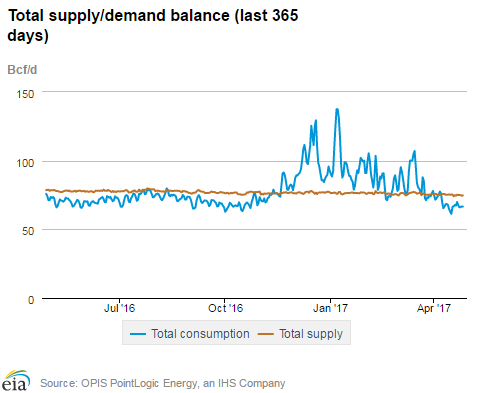
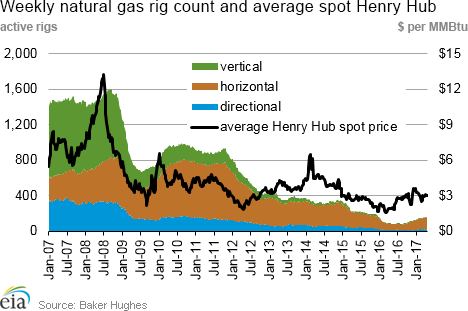
| Rigs | |||
|---|---|---|---|
Fri, April 21, 2017 |
Change from |
||
last week |
last year |
||
| Oil rigs | 688 |
0.7% |
100.6% |
| Natural gas rigs | 167 |
3.1% |
89.8% |
| Note: Excludes any miscellaneous rigs | |||
| Rig numbers by type | |||
|---|---|---|---|
Fri, April 21, 2017 |
Change from |
||
last week |
last year |
||
| Vertical | 79 |
2.6% |
54.9% |
| Horizontal | 718 |
1.7% |
116.3% |
| Directional | 60 |
-6.3% |
25.0% |
| Source: Baker Hughes Inc. | |||
| Working gas in underground storage | ||||
|---|---|---|---|---|
Stocks billion cubic feet (Bcf) |
||||
| Region | 2017-04-21 |
2017-04-14 |
change |
|
| East | 303 |
278 |
25 |
|
| Midwest | 504 |
487 |
17 |
|
| Mountain | 149 |
144 |
5 |
|
| Pacific | 228 |
223 |
5 |
|
| South Central | 1,005 |
983 |
22 |
|
| Total | 2,189 |
2,115 |
74 |
|
| Source: U.S. Energy Information Administration | ||||
| Working gas in underground storage | |||||
|---|---|---|---|---|---|
Historical comparisons |
|||||
Year ago (4/21/16) |
5-year average (2012-2016) |
||||
| Region | Stocks (Bcf) |
% change |
Stocks (Bcf) |
% change |
|
| East | 428 |
-29.2 |
356 |
-14.9 |
|
| Midwest | 552 |
-8.7 |
387 |
30.2 |
|
| Mountain | 155 |
-3.9 |
122 |
22.1 |
|
| Pacific | 276 |
-17.4 |
243 |
-6.2 |
|
| South Central | 1,136 |
-11.5 |
783 |
28.4 |
|
| Total | 2,547 |
-14.1 |
1,890 |
15.8 |
|
| Source: U.S. Energy Information Administration | |||||
| Temperature – heating & cooling degree days (week ending Apr 20) | ||||||||
|---|---|---|---|---|---|---|---|---|
HDD deviation from: |
CDD deviation from: |
|||||||
| Region | HDD Current |
normal |
last year |
CDD Current |
normal |
last year |
||
| New England | 86 |
-43 |
-37 |
0 |
0 |
0 |
||
| Middle Atlantic | 62 |
-50 |
-30 |
2 |
2 |
2 |
||
| E N Central | 44 |
-70 |
-30 |
4 |
4 |
4 |
||
| W N Central | 58 |
-47 |
0 |
6 |
5 |
6 |
||
| South Atlantic | 15 |
-38 |
-39 |
32 |
16 |
15 |
||
| E S Central | 5 |
-43 |
-28 |
32 |
27 |
31 |
||
| W S Central | 2 |
-19 |
-19 |
51 |
29 |
24 |
||
| Mountain | 72 |
-37 |
-34 |
12 |
4 |
6 |
||
| Pacific | 58 |
-5 |
27 |
0 |
-3 |
-5 |
||
| United States | 45 |
-41 |
-18 |
16 |
9 |
8 |
||
|
Note: HDD = heating degree day; CDD = cooling degree day Source: National Oceanic and Atmospheric Administration | ||||||||
Average temperature (°F)
7-Day Mean ending Apr 20, 2017
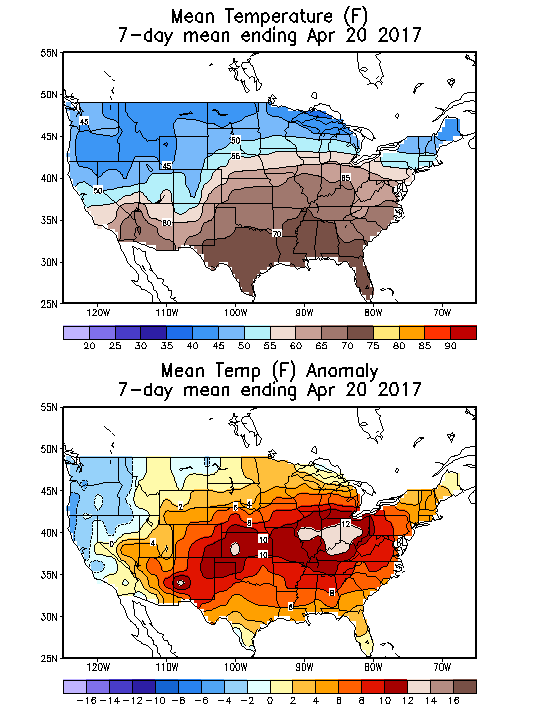
Source: NOAA National Weather Service
Deviation between average and normal (°F)
7-Day Mean ending Apr 20, 2017

Source: NOAA National Weather Service

